In our Gadgetstress lab we test not only expensive and popular cell phones but also low-end devices produced for a wide range of customers. In this review we are going to tell you about the results of the stress test of a Nokia 2330 classic. There are few extra functions. So this phone is used mostly for making calls.
The delivery package is as usual. In a small box (pic. 1) you’ll find a battery charger and a headset of course (pic. 2). You can have a look at pic. 3, 4 in order to see the design of the phone. The Nokia 2330 is all plastic. The keypad is monolithic and it is a part of the handset except the middle vertical line of the keys. It is strange to see an ear-microphone cap in the phone of such a price bracket. By the way an ear-microphone cap is rare for “Nokia” handsets. We hope that this advantage will help the Nokia 2330 pass successfully our dust test and immersion in a liquid. We wish you good luck dear Nokia 2330! Let’s start this torture test.
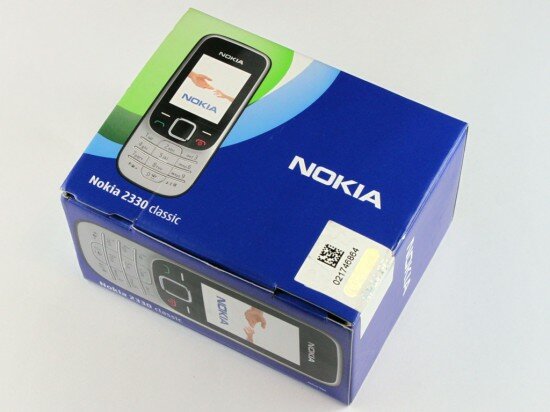
Pic.1. The box
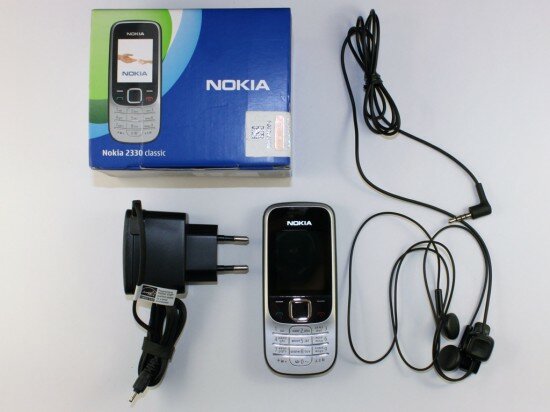
Pic.2. Delivery package
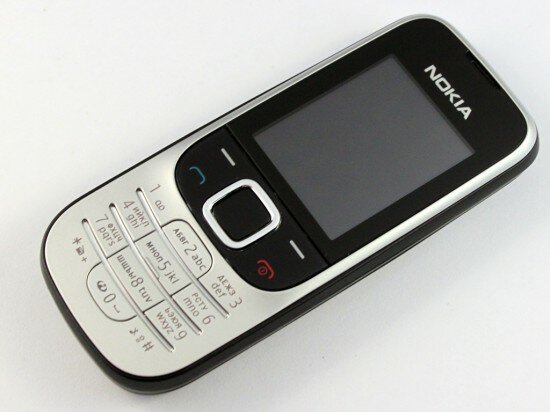
Pic.3. Front side

Pic.4. Back side
1. Stress test of the Nokia 2330 classic. Stage 1 – ability to withstand light shocks
1.1 Drop test
Drop-down is a common reason of the Nokia 2330 smashing and not all handsets are able to survive this test. According to our experience plastic handsets are more ruggedized than metallic because they weaken all blows and save the inner electronic components. Such cell phones can be slightly deformed after falling down but they usually work well afterwards.
We sequentially dropped the Nokia 2330 down onto each face, edge and corner from 1m on the carpet (video 1) and from 30cm on the ceramic tiles (video 2). Video 1 shows that once the back cover opened when the phone hit the carpet. But when we dropped it on the tiles nothing bad happened. The handset was not damaged.
Video 1. Drop-down on the carpet from 1m
The grade is 30 from 30 possible.
Video 2. Drop-down on the tiles from 30cm
The grade is 30 from 30 possible.
1.2 Squeeze test
Everybody knows that a phone may be broken if you step on it. Sometimes it may be not. That is why we carried out the squeeze test. We put the phone on a table and applied a 3kg pressure from a wooden bar above (pic. 5).
The Nokia 2330 passed the stress test well because the back part of it has no raised parts. So the pressure was spread all over the handset.
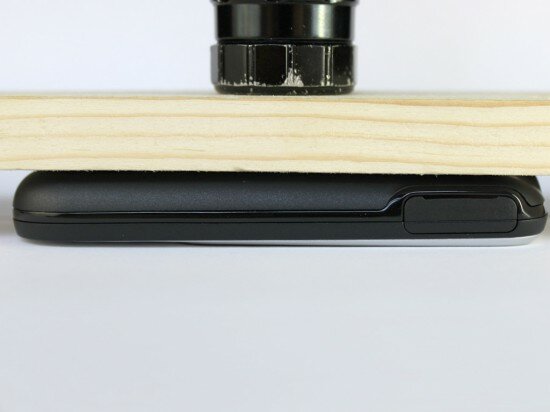
Pic.5. The phone under the wooden bar
The grade is 24 from 24 possible
1.3 Twist test
Twist test is similar to a squeeze test. The only difference is that some parts of the phone are pressed harder and some weaker. Irregularly distributed load is a common threat for any device.
In this stress test we put the Nokia 2330 onto the two planks so that each edge of the phone lay on a plank. Then we hitched a rope with 1kg load over the phone (pic. 6). The phone passed the test with no problem.
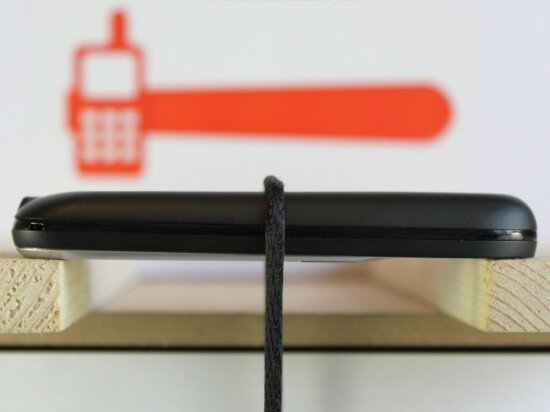
Pic.6. Twist test
The grade is 24 from 24 possible
1.4 Ruggedness
In order to have a look at the phone after some years of carrying it in a trouser pocket we made the following stress test. We placed the Nokia 2330 into a drum with keys, pennies and plastic balls to simulate what might be happening in a man’s trouser pockets while carrying a handset there. The drum rotated for 5 min at the speed of 500rpm (video 3).
Fortunately the Nokia 2330 easily survived though the display was a bit damaged (pic. 7). There were also some scratches at the edges of the handset (pic. 8). There were also two small cracks (pic. 9) at the back. But it did not stick out like a sore thumb. It struck the eye only in the bright light.
Video 3. Rotation of the drum
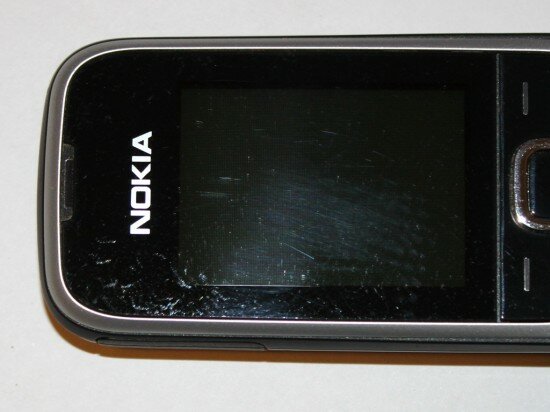
Pic.7. Damage of the display
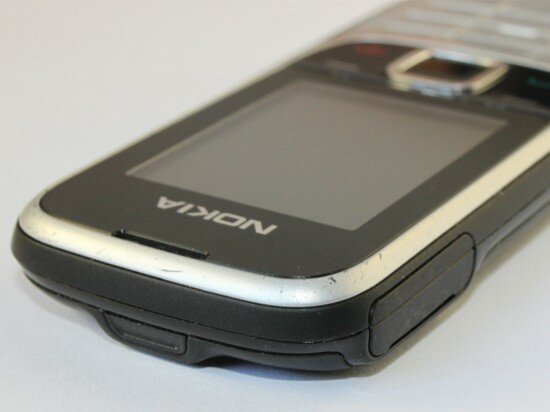
Pic.8 Scratches at the edges
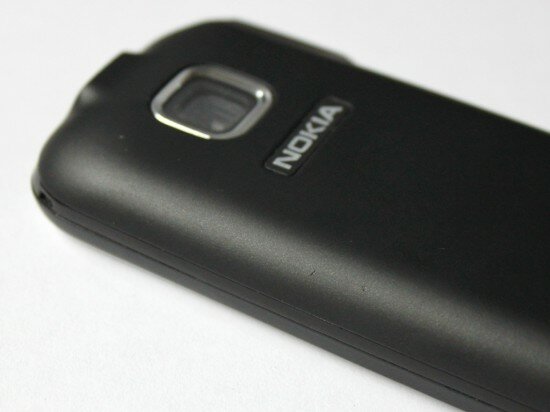
Pic.9 Cracks at the back
The grade is 10 from 15 possible
1.5 Material quality test
Another way to know whether a handset is ruggedized is to scratch it with a nail. We scratched the display of the Nokia 2330 and the back cover with a nail at the force of 100g (video 4). No scratches at all – that was the result.
Video 4. Scratching the display
The display gets 15 from 15 possible
The back cover gets 15 from 15 possible
1.6 Hot temperature
We made a thermal test. The point was that we laid the Nokia 2230 close to the electric bulb. In order to create worse conditions we put everything in a metallic container. The experiment lasted for 3 min. (video 5).
The video shows that the gadget passed this test perfectly.
Video 5. Hot temperature test
The grade is 12 from 12 possible
1.7 Dust test
In our accelerated-life-testing laboratory we try to simulate real situations that can happen in a life of a cell phone. Dust is a great threat for any gadget and it is almost everywhere. You can not get rid of it. So we carried out a dust test. We put the phone into an enclosed tray with dust thrown in with the Nokia 2330. Then we vibrated it violently for 2 min.
After the test we examined the Nokia 2330 (pic. 10). The battery cover was not shifted – it was attached closely to the handset. It saved the battery from the dust (pic. 11). The ear-microphone cap also did not allow grime to penetrate inside the jack (pic. 12). However the keypad was unprotected. There was so much dust inside that the upper row of the keypad creaked when we pressed it. The grime was also under the camera window lens glass and it was impossible to clean it because of the design of the camera (pic. 13). We spent most of the time cleaning the keypad.
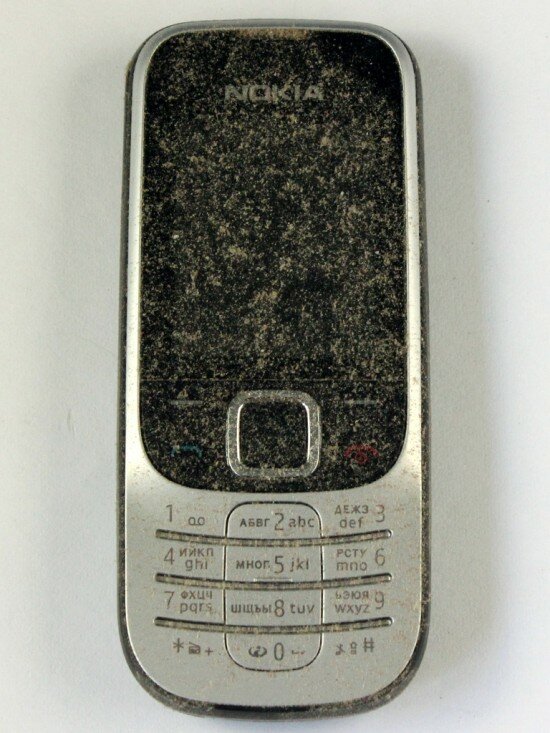
Pic.10 Face of the phone after the test
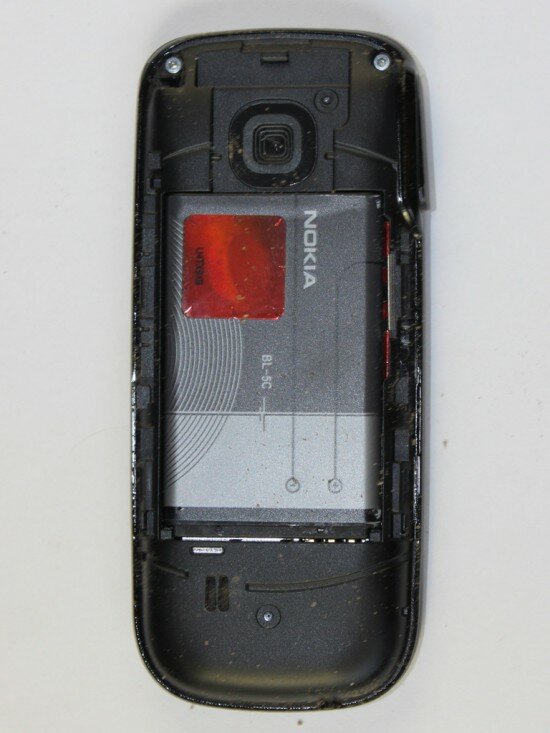
Pic.11 Dust under the back cover

Pic.12 Dust inside the ear-microphone jack
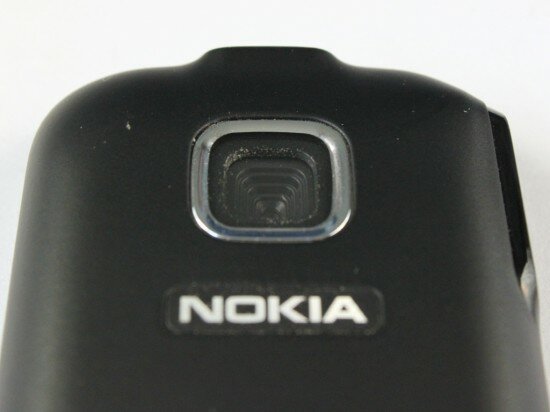
Pic.13 Dust under the camera window lens glass
The grade is 15 from 15 possible
1.8 Signal reception
The main function of any cell phone (especially a low-end one) is making calls. The lack of extra functions in cheap handsets should be compensated by a perfect signal reception. In order to check how the Nokia is good at calling we put the handset into a shielded box with 40×50mm hole (video 6). The indicator of the Nokia 2330 showed that the signal reception fell by 1 point when we made a call. But the phone received all the calls with no problem and in a standby mode the signal reception was great.
Video 6. Signal reception quality test
The grade is 15 from 15 possible
The grade for the 1st stage of the stress test of the Nokia 2330 is 187 (from possible 192)
2. Stress test of the Nokia 2330 classic. Stage 2 – tougher conditions
2.1 Drop test
This time the height of the drop-down on the carpet was 1,5m and on the tiles was 50cm (video 7, 8). When the Nokia 2330 fell on the carpet the back cover opened. For the second time the battery and the cover fell out. However the handset survived falling on the tiles better – the back cover opened only once. This stress test did not damage the 2330.
Video 7. Drop-down on the carpet from 1,5m
The grade for the drop-down on the carpet is 30 from possible 30.
Video 8. Drop-down on the tiles
The grade for the drop-down on the tiles is 30 from possible 30.
We increased the applied pressure to 10kg. It was not enough to damage the Nokia 2330. The handset passed the stress test with no problem.
The grade is 24 from 24 possible
2.3 Twist test
We increased the weight of the load on the rope to 5kg. The Nokia 2330 twisted – it was clearly seen (pic. 14). Fortunately all the electronic components of the Nokia were safe. The handset survived.
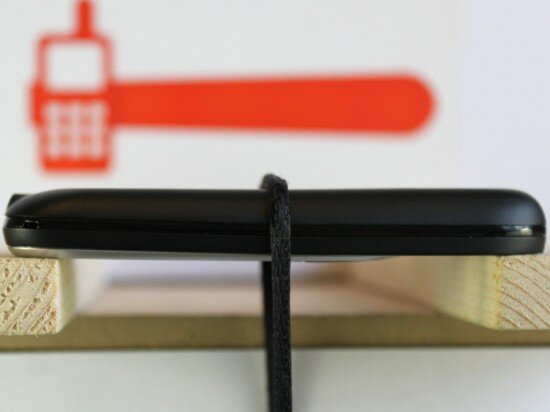
Pic.14 Twist test (the load is 5kg)
The grade is 24 from 24 possible
2.4 Ruggedness
The Nokia 2330 passed the first stage of this experiment successfully. So we decided to know what would happen to the Nokia if the stress test lasted for 10min. This time the display was more damaged (pic. 15). There were some scratches on the faceplate. More scratches appeared at the back. But among all parts of the phone the back cover was the most ruggedized.
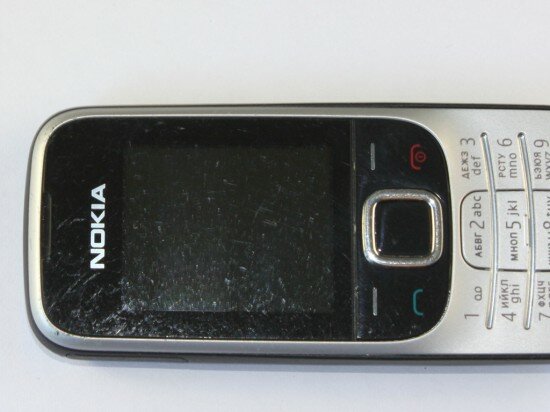
Pic.15 Damage of the display
The grade is 10 from 15 possible
2.5 Material quality test
This time the force of scratching was 300g. We failed to make a scratch on the display. But the nail made a scratch at the back (video 9).
Video 9. Scratching the handset
The display gets 15 from 15 possible
The back cover gets 10 from 15 possible
2.6 Freeze test
Low-end cell phones are not produced to work in extreme conditions, e.g. low temperature. In such environments cell phone batteries lower too fast and image on the screen may hang up. In this stress test we put the Nokia 2330 in a freezer for 2 hours. All this time the phone was in a speaking mode. After the experiment was over we took the phone out (video 10). The battery was absolutely full but the image on the screen hung up sometimes. The keypad disappointed us most of all – it was very hard to press the buttons.
Video 10. Freeze test
The grade is 18 from 18 possible
2.7 Hot temperature
In the 2nd stage we increased the time of the test to 5min. Surprisingly our plastic handset survived and the display did not turn black. The result was the same as in the previous test.
The grade is 12 from 12 possible
2.8 Immersion in water
If you want to damage a cell phone it is enough to take it by wet hands or to leave it in a humid environment. But we went further and dunked the Nokia 2330 under water for 1sec. (video 11). It did not damage the phone. Very little water penetrated under the back cover (pic.17). The ear-microphone cap protected the jack well (pic. 16). However the sound out of the speaker became lower. But after we dried the handset it was normal again.
Video 11. Immersion in water for a sec.
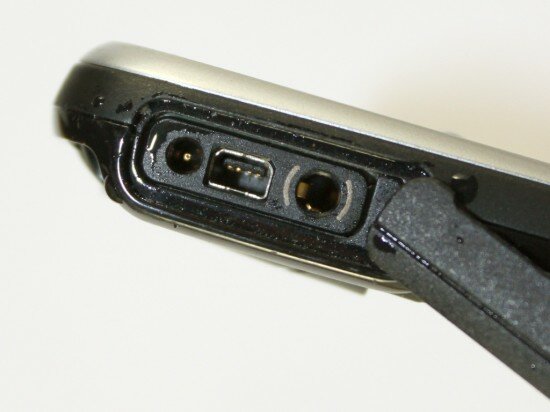
Pic.16. The ear-microphone jack after the test
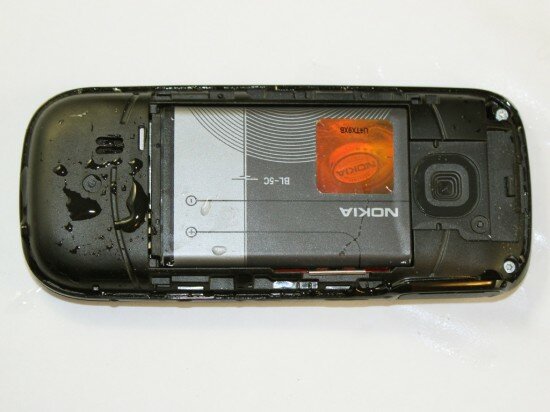
Pic.17. The back cover after the test
2.9 Dust test
We increased the time of violent vibration of the enclosed tray with the Nokia 2330 and dust inside to 5 min. As a result some dust managed to penetrate into the ear-microphone jack and under the camera window lens glass. The keypad creaked again when we pressed it. The result was similar to the previous dust stress test.
The grade is 12 from 12 possible
2.10 Signal reception
We created worse conditions for receiving calls than in the 1st stage. For this stress test we made a smaller hole in the shielded box (20×20 mm). The indicator showed 1 point of signal reception (video 12). Bur the Nokia 2330 received all 10 calls with no problem.
Video 12. Signal reception test
The grade is 15 from 15 possible
The grade for the 2nd stage of the stress test of the Nokia 2330 is 230 (from possible 240)
3. Stress test of the Nokia 2330 classic. Stage 3 – the toughest conditions
3.1 Drop test
The maximum height of the drop on the carpet was 2m (video 13) and 1m on the tiles (video 14). The drop on the carpet did not reveal anything new – the back cover and the battery fell out. When the Nokia 2330 fell on the tiles the faceplate shifted. We put it back and continued the test with no problem. The phone survived.
Video. 13 Drop-down on the carpet from 2m
The grade is 30 from 30 possible
Video. 14 Drop-down on the tiles from 1m
The grade is 30 from 30 possible
3.2 Squeeze test
The maximum pressure in this stress test was 20kg. The design of the Nokia 2330 saved it from crack. The handset made no creak.
The grade is 24 from 24 possible
3.3 Twist test
We increased the weight of the load on the rope to 10kg. The handset twisted greatly (pic. 18) but worked perfectly.
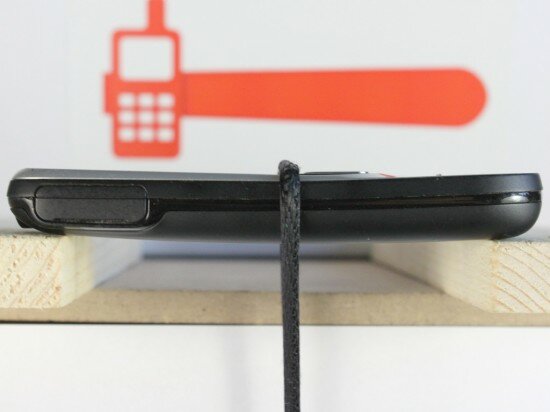
Pic.18 The twist was very clear
The grade is 24 from 24 possible
3.4 Ruggedness
The maximum time of the torture in the drum was 20min. The result was not as good as we wanted to have. The security shield of the display was damaged (pic. 19). It was quite noticeable. The silvery fringe suffered more than in the 1st stage of this stress test. We could easily see a black plastic through the silvery cover (pic. 20). A lot of cracks were made at the corners of the phone (pic.21). The Nokia 2330 looked as it had been used for a long time.
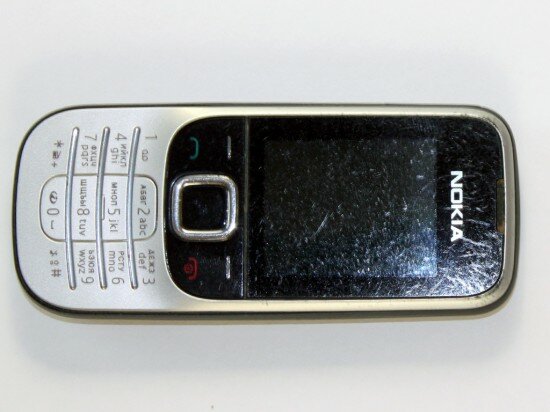
Pic19 Damage of the display
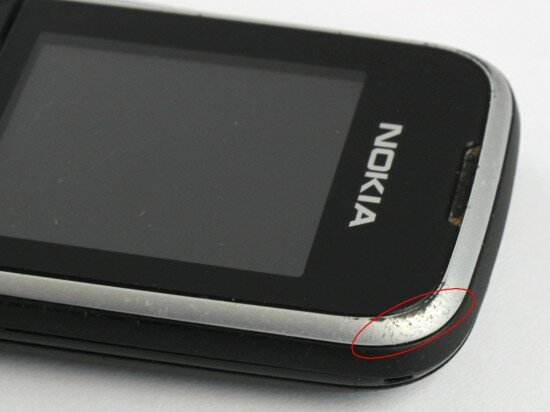
Pic.20 Damage of the corners
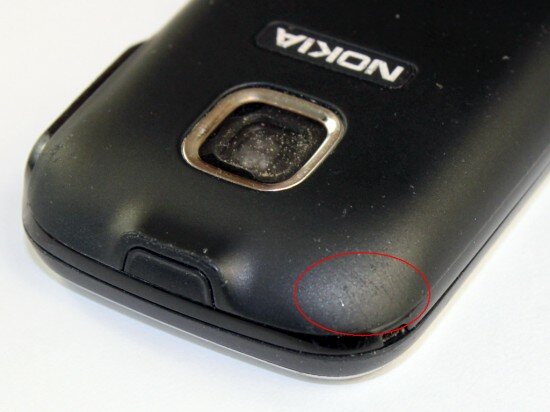
Pic.21 Damage at the back part of the phone
The grade is 10 from 15 possible
3.5 Material quality test
We doubled the force of scratching (600g). At last we managed to scratch the display. However, the scratch was not deep at all (video 15, pic. 22). The nail cut off a piece of the cover of the handset. The damage was clearly seen (video 16, pic. 23).
Video. 15 Scratching the display
Video. 16. Scratching the handset
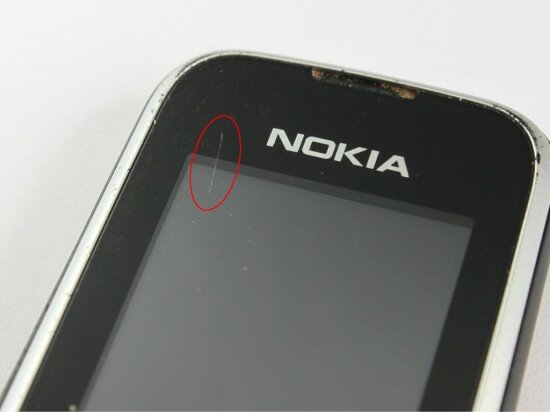
Pic.22. Scratch on the display
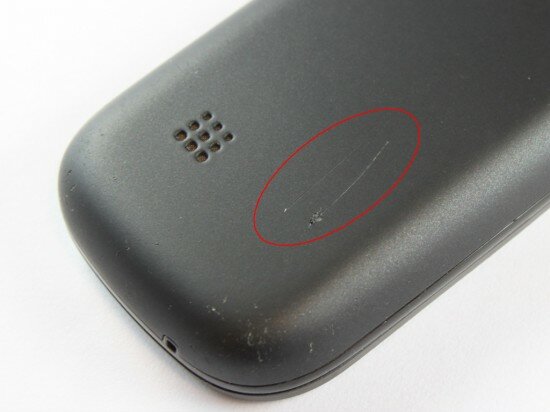
Pic.23. Scratch on the back cover
10 points (from 15 possible) for the screen
10 points (from 15 possible) for the back cover
3.6 Hot temperature
In order to make sure that the Nokia 2330 classic can work perfectly after being heated by the sun we increased the time of the test to 10min. (video 17). When we took the gadget out of the container we thought that it was either switched off or broken. But when we pressed the keys we heard the sound out of the loudspeaker. It proved that the phone was on. The point was that the display turned black. Fortunately the color brightness restored and after we cooled the Nokia down to a room temperature the colors were as bright as before the test. Surprisingly the keypad and the handset itself were safe. Unfortunately after some time we noticed that the glazy embedments of the softkeys melted a bit.
Video 17. Hot temperature test
The grade is 12 from 12 possible
3.7 Immersion in water
The Nokia 2330 survived immersion for 1sec. But what would happen to this phone if we dunked it under water for 20sec. (video 18). The result was the same. The phone worked after the test. However, much water penetrated under the back cover (pic. 24). There was also a lot of water inside the ear-microphone jack. Fortunately the contact fingers were safe (pic. 25). We dried the phone with warm air after the test.
Video 18. Immersion in water
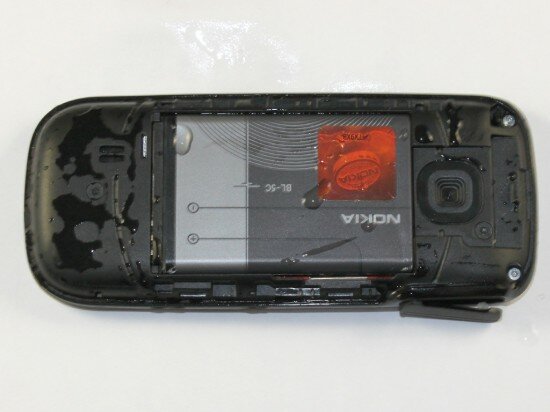
Pic.24. Water under the battery cover
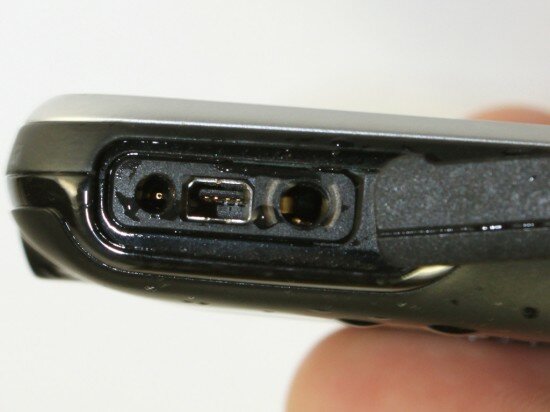
Pic.25. The ear-microphone jack after the test
The grade is 30 from 30 possible
3.8. Immersion in beer
We’ve got a plenty of beer in our lab. But we are not boozers. We use beer mostly for stress tests. This time we dunked the 2330 under beer for 10sec. Video 19 shows that the beer did not damaged the Nokia 2330. Thanks to the ear-microphone cap the 2330 did not even demonstrate its connection with the headset which is a common feature for “Nokia” cell phones (pic. 27). By the way mini jack is more reliable than the original one. When we took off the back cover we understood that the beer penetrated even under the battery (pic. 26). Probably it did not damage the circuit board as there was no corrosion. After the experiment we washed the handset and dried it as we usually do.
Video 19. Immersion in beer
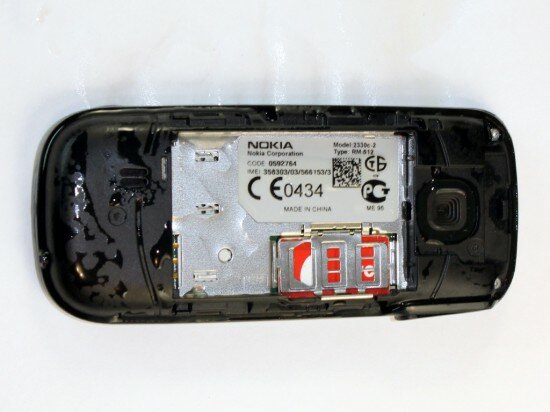
Pic.26. The spots made by the beer under the battery
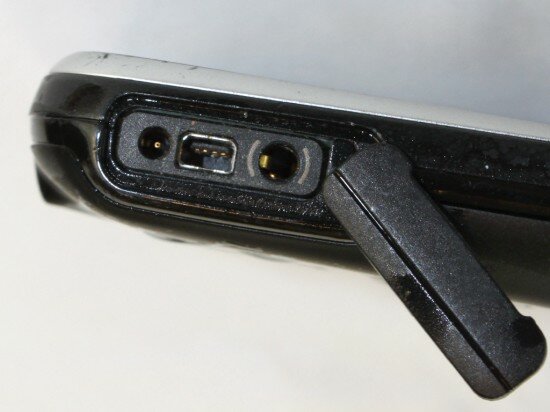
Pic.27. The ear-microphone jack after the test
The grade is 9 from 9 possible
3.9 Dust test
We increased the time of this stress test to 10min. We were not surprised when we saw little dust under the back cover (pic. 28). The same we experienced in the previous dust tests. But the loudspeaker, the microphone and the keypad were full of dust (pic. 29). It was hard to press the keys. It took a long time and great efforts to get rid of the dust in the loudspeaker. Fortunately the sound quality was normal. But the look of the Nokia 2330 changed for the worse.
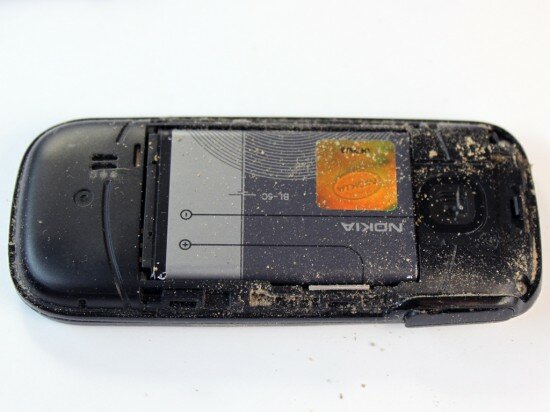
Pic.28. Dust under the back cover

Pic.29. Dust in the loudspeaker
The grade is 12 from 18 possible
3.10 The keypad
The keypad really disappointed us. After all the stress tests it still worked but the quality left much to be desired. According to its design there is a space under the keys which is easily stuffed with dust and grime. That is why the keypad creaked after all the dust tests. It also worked badly in cold weather – we could hardly press the keys. By the way the keypad is made of the same material as the fringe of the faceplate. We said earlier that it was badly damaged. Consequently the same will happen to the keypad sooner or later. The only advantage is that the keypad is not afraid of a hot temperature.
The grade is 10 from 15 possible
3.11 Signal reception
We made much smaller hole in the shielded box (15×15 mm) than in the previous tests. The result was the same as in the 2nd stage (video 20). Though the indicator showed only 1 point of signal reception the phone received all the calls with no problem. That’s a very good result.
Video 20. Signal reception test
The grade is 15 from 15 possible
3.12 Electrical overload
We began this experiment as usual – with testing the charging unit. We made a short-circuit of the power supply terminals for 1sec. (video 21). It did not break the battery of the Nokia 2330 charger.
Video 21. Short-circuit of the battery charger
The grade is 15 from 15 possible
Then we made a short-circuit of the battery. Video 22 shows that the battery survived. It did not even lower.
Video 22. Short-circuit of the battery
The grade is 15 from 15 possible
Then we discovered minimum and maximum charging voltage (video 23). We plugged the cord of the battery charger in a PSU. The standard voltage of charging was 5V. Then we were gradually decreasing the voltage. The charging stopped at 4V. So the minimum voltage of charging is around 4V. In order to know the maximum charging voltage we were gradually increasing the voltage. When we reached 8V the phone was still being supplied with energy. We did not exceed the voltage supply – it could break the phone. So we stopped the experiment. The Nokia 2330 passed the test perfectly.
Video 23. Minimum and maximum charging voltage
The grade is 15 from 15 possible
In order to discover the Nokia’s 2330 energy consumption we plugged the PSU in the phone instead of the battery. At first we were increasing the energy supply and when we reached 8V the phone was still OK. Then we were decreasing the energy supply and when we reached 3V the phone switched off (video 24). Anyway the 2330 passed this test successfully.
Video 24. Energy consumption
The grade is 15 from 15 possible
3.13 Disassembling, build quality
The inner components of the Nokia 2330 are usual for the cell phones of such a class (piс. 30). The keypad is a part of the circuit board which is designed in such a way that its components are brazed only to one side. It makes the gadget cheaper (piс. 31).
There is a very interesting thing. The camera is very big if you look at the Nokia 2330. But we could not even imagine how tiny it is inside the phone (piс. 31, at the right). The build quality is quite good for the phone of such a price bracket. The inner design (arrangement of the components on the circuit board) proved its value long ago.
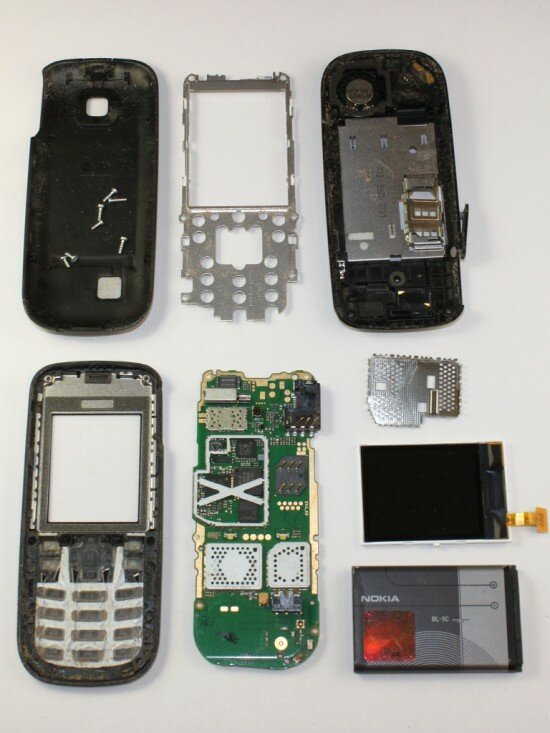
Pic.30. The 2330 taken apart

Pic.31. Circuit board
The grade is 15 from 15 possible
The grade for the 3rd stage of the stress test of Nokia 2330 is 322 (from possible 351)
Conclusion
We did not expect that the Nokia 2330 classic would pass all the stress tests perfectly. But it did very well. It was not damaged by the liquids. It was safe after the drops. It survived the bake test. But the keypad is its disadvantage. If you work in dusty environmental conditions or if you are going to use a cell phone in cold weather Nokia 2330 classic is not the best choice for you.
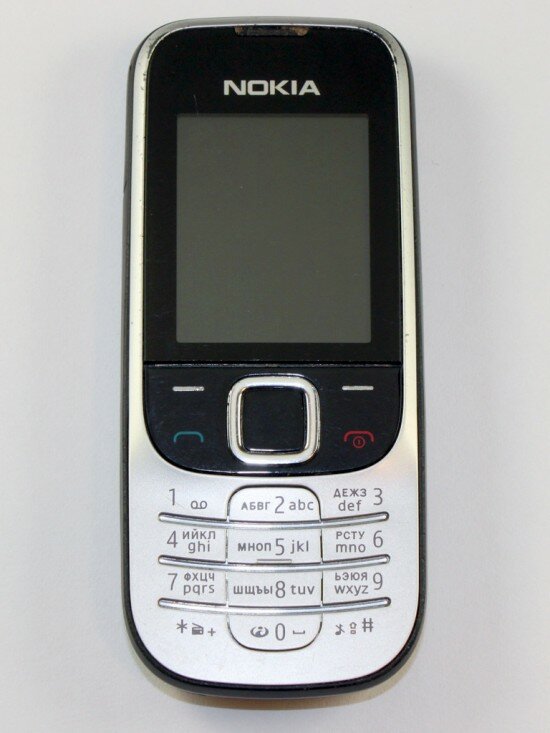
Pic.32. The face of the Nokia 2330

Pic.33. The back of the Nokia 2330

 Russian version
Russian version